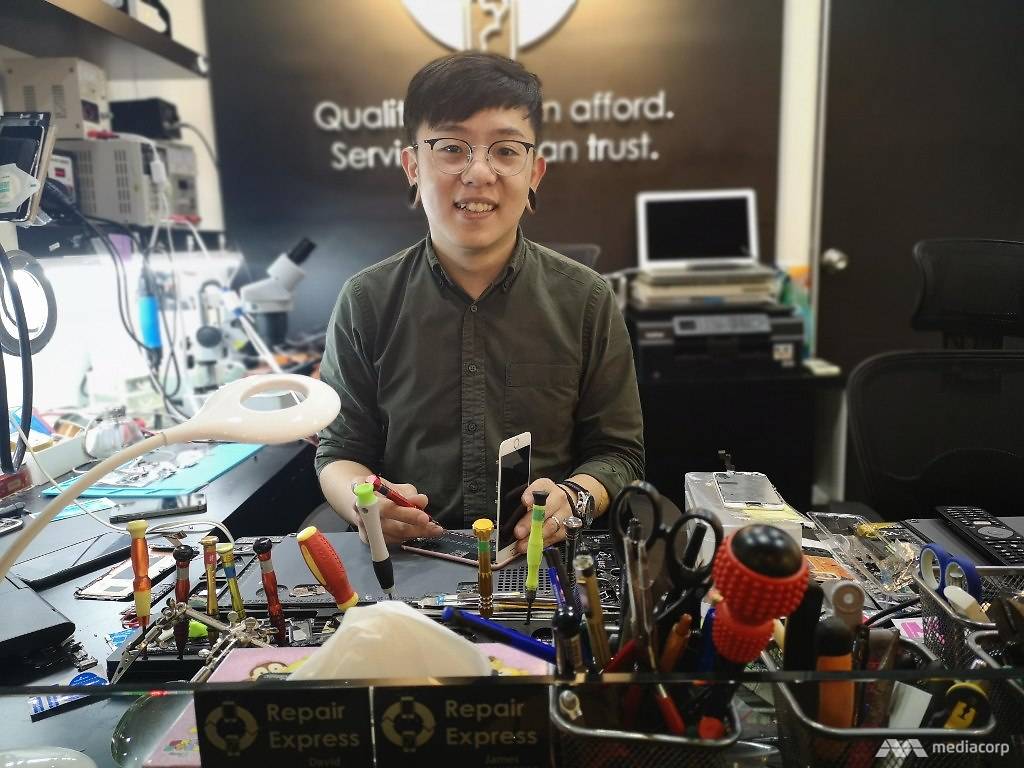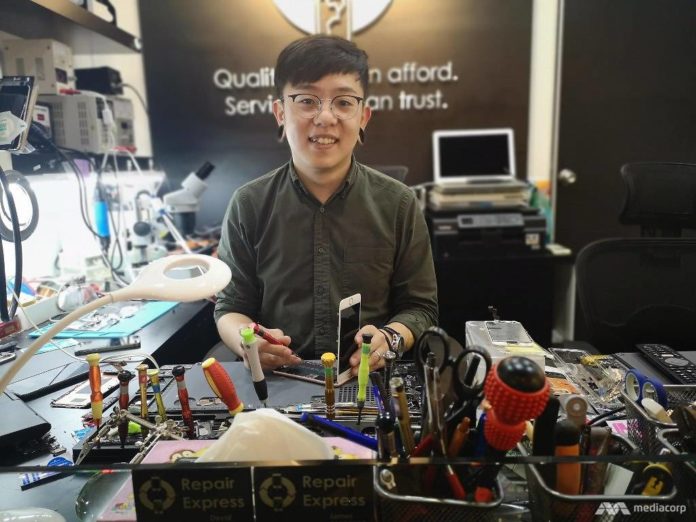SINGAPORE: Their loud, garish neon lights make them easy to spot in heartland town centres. Their unique selling proposition – “cheaper than what the authorised service centre will charge” – calls out like a siren when our mobile devices “die” an untimely death.
One such mobile phone repair business is Repair Express, whose co-founder, 28-year-old David started off as an apprentice at Sim Lim Square – one of Singapore’s well-known IT enclaves.
His workspace is a nondescript office in the middle of Crawford Lane. Flickering near the entrance was a big, flat-screen TV hooked up to YouTube and showing videos of mobile devices being fixed or taken apart. David was sat bent over fiddling with a dissembled smartphone when Channel NewsAsia walked in on him one afternoon.
It has been his bread-and-butter for the past four years, supported by what he described as a steady stream of customers.
On average, he gets 15 to 20 customers a day, or 500 to 600 customers each month. Setting up shop away from the retail hotspots means avoiding the costly overheads and these savings are passed on to his customers, he said.
Another key selling point: Repair Express is open at all hours of the day.
This allows it to capture an underserved demographic: “You’ll be surprised, I get about three to four customers a week during the 4am-to-7am time slot,” David shared.
But are businesses like his up to the task of fixing that Apple or Samsung phone packed with the latest technology?
ON THE JOB TRAINING
The budding entrepreneur shared that everything he knows about fixing phones is self-taught. This means seeking out support groups and forums whose members share their expert insights and techniques. And as a last resort – trial and error, he said.
“We rely on the combined wisdom of the mobile repair industry,” David said, and this means watching fix-it videos and tutelage from others in closed forums and Facebook groups.
Those looking to join these closed groups in the tight-knit community will have to answer a series of technical questions and provide links to their repair businesses before moderators allow them entry.
“One of the questions I was asked is: ‘If there’s a vertical green line on the screen, what’s the reason for it?’” David recounted.
Once in, he said “it’s a positive environment” where people are generally open to sharing their knowledge and helpful when answering queries from others.

David says Repair Express gets about 500 to 600 customers a month, but this number has been dropping in recent times.
Knowledge sharing seems to be the main way skills of the trade are picked up.
Aaron Goh, operations manager at uBreakiFix, shared that his company provides a structured in-house training programme where new employees are paired up with senior technicians to learn skills such as diagnostics and repair work ranging from simple battery and screen replacements to more complicated issues like water damage.
Newer ones are usually given theoretical briefings on the types of faults and the likely causes and allowed to practice on dummy sets before moving on to customers’ devices only when confident – but with supervision.
His main challenge today? Newer curved screen models like Samsung Galaxy Note 8 and 9.
Aaron told Channel NewsAsia: “This is because the parts are more delicate and expensive … There are also more steps to disassemble then reassemble such phones.
“Other phones which are more difficult to repair are the less commonly used phones mainly because we have less exposure to such phones and less opportunity to practice (on them).”
GETTING HELP FROM AFAR
Beyond online support, Repair Express’ David said technicians would make trips to places like China where the refurbishment of mobile phones is a “very big market”, he said.
For example, David said there aren’t many in Singapore who knows how to fix a faulty curved display screen – a component that is increasingly common in the latest phones such as Samsung’s Galaxy 9 and Huawei’s Mate 20.
Repairing these screens can be a highly technical affair involving heating pads, glue, thin wires, chemicals and a vacuum chamber. But delicate parts could be damaged in the process.
Another method available now promises less harm to the device. This involves freezing the phone in a cooling machine to -190 degrees, which makes the screen easy to remove, David said.
“Heat causes damage to screens and underlying wires; freezing doesn’t,” he explained. But at about S$8,000 to S$10,000 each, the machine is certainly not a small investment.
Yet, he sees value in knowing how to fix such screens. Together with an unnamed partner company, he has coughed up the funds to allow two technicians to learn the technique in China. The two have been there since February, and will only be back at the end of the year, he revealed.
It costs about S$3,000 a month just for their living expenses and “tuition fees”. Buying the screens for them to practice on is an additional expense, he added.
Such commitment to improving one’s tradecraft is aligned with David’s business philosophy of focusing on branding and quality of the service to stay relevant and in demand.
“All my customers know I’m not the cheapest around,” he said, “But they know what they are getting: Yi fen qian, yi fen huo (Chinese saying for paying more for quality).”
While uBreakiFix does not send people overseas for training, Aaron said technicians and suppliers from markets like China will demonstrate to its senior technicians how to repair the more delicate parts on the latest Samsung phones or remove the cameras on phones ranging from OnePlus and Apple to Xiaomi and Oppo.
Camera removal is a service “regularly requested” by customers who work in sensitive or secure work environments or National Servicemen, he shared.

Repairing broken phones are getting more challenging as manufacturers move towards more complex and delicate components like curved screens. (Photo: uBreakiFix/Facebook)
“Only China technicians possess such unique skill sets,” Aaron said. “They are willing to show our technicians the ropes because we procure repair parts from them.
“Usually these Chinese technicians learn from their own contacts who work with the brand owners or phone manufacturers,” he added.
CHALLENGING CLIMATE
However, even as mobile phone repairmen here look to upgrade their skillsets, external factors are posing a threat to their livelihoods.
One of these is the introduction of the latest and more technologically advanced phones within a short span of time by the smartphone makers. This is being done with greater regularity.
Indeed, a report by Euromonitor International released in August this year stated that while there is already an “extremely high” household penetration rate in terms of mobile phone sales, sales figures for the devices will continue to remain strong in Singapore.
READ: When should children be allowed to have their own mobile phones? A commentary
It forecasts mobile phone sales to hit about 2.78 million this year, comparable with 2017’s 2.79 million sold.
File photo of people showing their smartphones. (AFP PHOTO / PHILIPPE HUGUEN)
“High disposable incomes and consumer interest in keeping abreast of the latest technological innovations are some of the factors contributing both to a stable rate of replacement sales and to value growth,” the research firm said in the report.
“Furthermore, through short-term mobile contracts, telecommunication operators offer consumers attractive incentives and subsidies to regularly upgrade their existing phones approximately every two years.”
This is currently being played out.
Already, industry leaders like Apple and Samsung have unveiled their latest models, as have rivals Google, Huawei, Xiaomi and even Razer.
Repair Express’ David acknowledged these market developments, but these short launch cycles are not what keeps him up at night.
What has most affected his customer base, he said, is the inexpensive insurance plans being offered by the telcos as a value-add service when a new mobile phone is purchased.
He said sales volume has “gone down quite a bit” and, when pressed, said in July, he saw about 300 customers – half of the usual figure cited above.
There is also increased competition from other mobile repair service providers – “nowadays, it is quite easy to learn how to repair phones like Apple’s iPhones from YouTube” – and lower charges levied by the official service centres, David pointed out.
It appears there are no quick fixes for mobile repair businesses but to collaborate and play catch-up with technology to stay relevant.





